Esa-Pekka Salonen, in double duty as conductor and composer, sparks energy surge with CSO
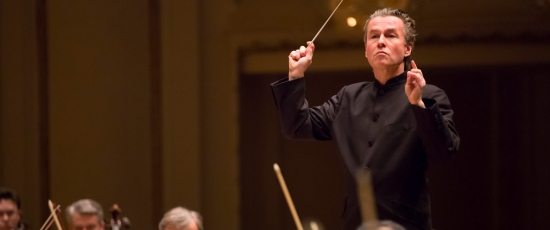 Review: Chicago Symphony Orchestra, Esa-Pekka Salonen conducting; Christian Tetzlaff, violin. April 10-13 at Orchestra Hall.
Review: Chicago Symphony Orchestra, Esa-Pekka Salonen conducting; Christian Tetzlaff, violin. April 10-13 at Orchestra Hall.
By Nancy Malitz
It has been an unforgettable month at the Chicago Symphony. Hard on the heels of music director Riccardo Muti’s two weeks in late March came a two-week visit of Esa-Pekka Salonen.
The Finnish-born, California-invigorated composer and conductor Salonen, at 55, could not be more robustly complementary in nature to the elegant 72-year-old Italian-born Muti, who has taught Chicago so much about the composers in close orbit to Vienna when it was the center of the cultural universe. In March, Muti made familiar Schubert seem new again, providing fresh insights into the Second, Eighth and Ninth Symphonies that seemed to summon the Chicago spring.
In April, Salonen, who has an equal and opposite knack for making new music sound familiar, introduced his own 2011 tone poem, “Nyx,” named after the mythical goddess of darkness at the dawn of creation. Audience response was electric. Salonen’s fortnight of featured composers included exciting works by Leoš Janáček, Béla Bartók, Jean Sibelius, Antonín Dvořák and Anna Clyne — all but two from the 20th century, and none earlier than 1879. (Christian Tetzlaff, in a powerhouse performance, was the soloist in Dvořák’s Violin Concerto.)
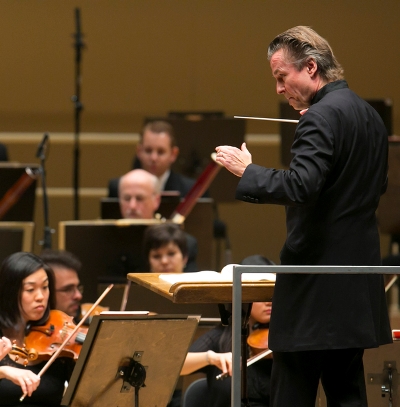 This is routine for both conductors. Muti has turned his hand to César Franck, Anton Bruckner and especially Giuseppe Verdi, with similar revelations about music we thought we knew. Salonen radiates uncommon comfort with composers of more recent vintage — Olivier Messiaen, Witold Lutosławski, György Ligeti, Magnus Lindberg, Kaija Saariaho and John Adams, along with 20th-century old-school Stravinsky and Schoenberg. He has a European sensibility, to be sure. But it’s clear Salonen feels the gravitational pull of Old Vienna less — and newer Nordic, Eastern and French influences more — distanced as he is by space and time.
This is routine for both conductors. Muti has turned his hand to César Franck, Anton Bruckner and especially Giuseppe Verdi, with similar revelations about music we thought we knew. Salonen radiates uncommon comfort with composers of more recent vintage — Olivier Messiaen, Witold Lutosławski, György Ligeti, Magnus Lindberg, Kaija Saariaho and John Adams, along with 20th-century old-school Stravinsky and Schoenberg. He has a European sensibility, to be sure. But it’s clear Salonen feels the gravitational pull of Old Vienna less — and newer Nordic, Eastern and French influences more — distanced as he is by space and time.
“Nyx” is a masterful noctural poem lasting 19 minutes. It is shaped by a sense of mystery, unsettling power and silent magic, giving way — at the very end — in a wisp of evanescence, as if to dawn’s first light. The first sound is very like a fog horn, with muted brass hanging onto the eerie edge of strings — and then comes a great gathering of horns, with an aura of ritual to it, as if the individual brass lines, each one pursuing a unique melody, were headed toward some previously ordained summit to bring on the night.
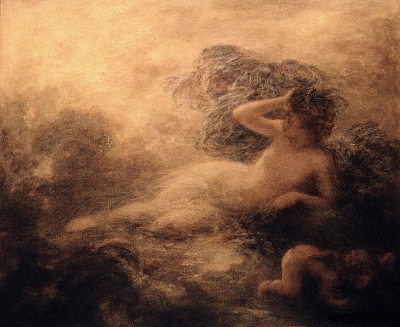 Musings for solo clarinet (the excellent John Bruce Yeh) seem to stand in for the experience of an individual alone, contemplating the night’s majesty, often wonderstruck, sometimes giddily florid. Much of this work for large orchestra is, as with Mahler, really chamber music in its moments of greatest intensity. Although Salonen’s music does not sound like Mahler, there is a similar command, as if spontaneously inspired, yet based on intimate practical knowledge of each instrument’s idiosyncrasies, alone and in formation.
Musings for solo clarinet (the excellent John Bruce Yeh) seem to stand in for the experience of an individual alone, contemplating the night’s majesty, often wonderstruck, sometimes giddily florid. Much of this work for large orchestra is, as with Mahler, really chamber music in its moments of greatest intensity. Although Salonen’s music does not sound like Mahler, there is a similar command, as if spontaneously inspired, yet based on intimate practical knowledge of each instrument’s idiosyncrasies, alone and in formation.
At about the halfway point, “Nyx” opens up quite magically into a twinkling expanse, seemingly timeless, with constellations of high mallets and string glissandi piling on for effect. Much of the final third is taken up by sweeping crescendos — with instruments moving not in unison but variously, in relentless Stravinsky-like rhythms — toward the surprising dissolve into lightness. The audience went crazy for “Nyx,” and Salonen, clearly gratified, basked in the ovation. (The piece has been recorded, along with Salonen’s Violin Concerto, heard in Chicago in 2011, for Deutsche Grammophon.)
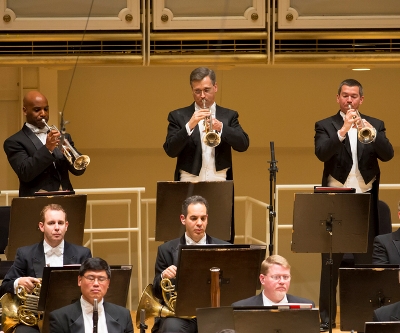 It was a night for all-out virtuosity. The concert was wrapped in a Janáček envelope. It began with the overture to his opera “From the House of the Dead,” which literally screams with uncertainty and fear even as it makes time for showstopping psychotic turns on solo fiddle (concertmaster Robert Chen). Janáček’s Sinfonietta, which ended the concert, was staged in a manner befitting this brass showpiece among showpieces — with eight trumpets arrayed across the organ choir loft and another three standing onstage while the rest of the orchestra, seated, merely relied on sensational playing. I doubt there was a soul in the applauding crowd who would have objected if Salonen, who conducted with the energy of Bernstein, had decided to play the entire piece again, as an encore.
It was a night for all-out virtuosity. The concert was wrapped in a Janáček envelope. It began with the overture to his opera “From the House of the Dead,” which literally screams with uncertainty and fear even as it makes time for showstopping psychotic turns on solo fiddle (concertmaster Robert Chen). Janáček’s Sinfonietta, which ended the concert, was staged in a manner befitting this brass showpiece among showpieces — with eight trumpets arrayed across the organ choir loft and another three standing onstage while the rest of the orchestra, seated, merely relied on sensational playing. I doubt there was a soul in the applauding crowd who would have objected if Salonen, who conducted with the energy of Bernstein, had decided to play the entire piece again, as an encore.
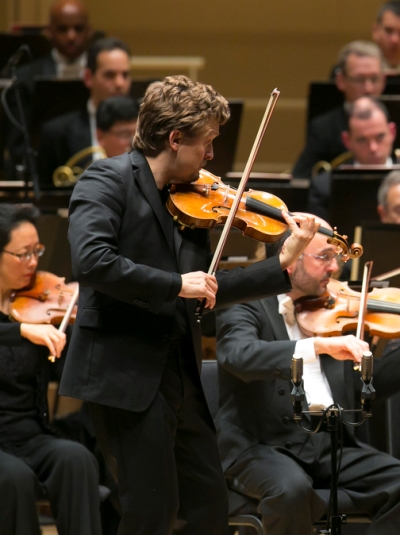 The surprise of the night, for me, was a collaboration between Christian Tetzlaff and Salonen on the Dvořák Violin Concerto. It’s saddled with the reputation of weakness in comparison to the more famous Cello Concerto, but this violinist and conductor were having none of that. Tetzlaff is one of our greatest solo violinists, blessed with physical strength and fierce intellectual intent. Not only could one hear the soloist at every moment, in part because of Salonen’s clever handling of orchestral textures, but one could also sense with consistency the big picture that Tetzlaff had in mind. The heroic opening movement was drenched in Brahmsian influence, the Adagio gorgeous and songlike, the rambunctious finale equal to the best in the romantic classical idiom. Perhaps not all violinists can have success with this work, but Tetzlaff owns it and Salonen was completely invested.
The surprise of the night, for me, was a collaboration between Christian Tetzlaff and Salonen on the Dvořák Violin Concerto. It’s saddled with the reputation of weakness in comparison to the more famous Cello Concerto, but this violinist and conductor were having none of that. Tetzlaff is one of our greatest solo violinists, blessed with physical strength and fierce intellectual intent. Not only could one hear the soloist at every moment, in part because of Salonen’s clever handling of orchestral textures, but one could also sense with consistency the big picture that Tetzlaff had in mind. The heroic opening movement was drenched in Brahmsian influence, the Adagio gorgeous and songlike, the rambunctious finale equal to the best in the romantic classical idiom. Perhaps not all violinists can have success with this work, but Tetzlaff owns it and Salonen was completely invested.
It was only in 2009 that Salonen stepped away from his music directorship of the Los Angeles Philharmonic, having amassed an impressive record of 120 world or American premieres, including 54 commissions. (See a partial list here.) He wanted more time to compose, he said at the time. He has not abandoned conducting, but rather struggles to contain it.
One can understand his dilemma without wishing that he stop conducting entirely. He has a talent like Pierre Boulez, the brilliant 89-year-old composer and Chicago Symphony Orchestra’s conductor emeritus, for bringing new music into focus by helping listeners make the necessary relevant connections. Salonen seems as busy mapping the universe of today’s music as Boulez did for the decades preceding. His openness to, and enthusiasm for, what comes next makes him an ideal ambassador. A continuation of his relationship with the Chicago Symphony can only be good for both orchestra and audience.
Tags: Christian Tetzlaff, Dvorak Violin Concerto, Esa-Pekka Salonen, Janacek House of the Dead, Janacek Sinfonietta, John Bruce Yeh, Nyx, Riccardo Muti

